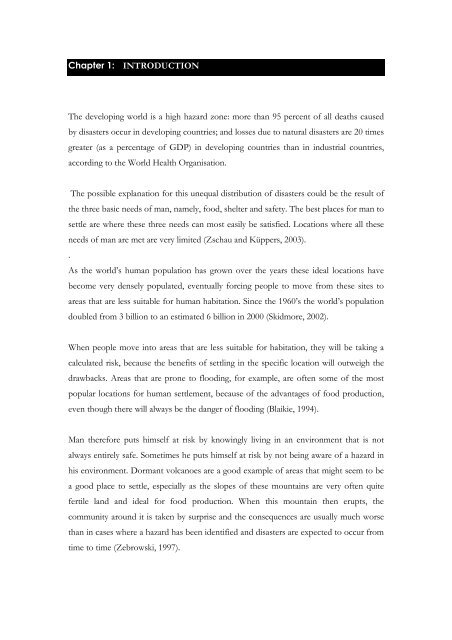A spatial multi-risk hazard assessment and vulnerability study of ...
A spatial multi-risk hazard assessment and vulnerability study of ...
A spatial multi-risk hazard assessment and vulnerability study of ...
Create successful ePaper yourself
Turn your PDF publications into a flip-book with our unique Google optimized e-Paper software.
Chapter 1: INTRODUCTION<br />
The developing world is a high <strong>hazard</strong> zone: more than 95 percent <strong>of</strong> all deaths caused<br />
by disasters occur in developing countries; <strong>and</strong> losses due to natural disasters are 20 times<br />
greater (as a percentage <strong>of</strong> GDP) in developing countries than in industrial countries,<br />
according to the World Health Organisation.<br />
The possible explanation for this unequal distribution <strong>of</strong> disasters could be the result <strong>of</strong><br />
the three basic needs <strong>of</strong> man, namely, food, shelter <strong>and</strong> safety. The best places for man to<br />
settle are where these three needs can most easily be satisfied. Locations where all these<br />
needs <strong>of</strong> man are met are very limited (Zschau <strong>and</strong> Küppers, 2003).<br />
.<br />
As the world’s human population has grown over the years these ideal locations have<br />
become very densely populated, eventually forcing people to move from these sites to<br />
areas that are less suitable for human habitation. Since the 1960’s the world’s population<br />
doubled from 3 billion to an estimated 6 billion in 2000 (Skidmore, 2002).<br />
When people move into areas that are less suitable for habitation, they will be taking a<br />
calculated <strong>risk</strong>, because the benefits <strong>of</strong> settling in the specific location will outweigh the<br />
drawbacks. Areas that are prone to flooding, for example, are <strong>of</strong>ten some <strong>of</strong> the most<br />
popular locations for human settlement, because <strong>of</strong> the advantages <strong>of</strong> food production,<br />
even though there will always be the danger <strong>of</strong> flooding (Blaikie, 1994).<br />
Man therefore puts himself at <strong>risk</strong> by knowingly living in an environment that is not<br />
always entirely safe. Sometimes he puts himself at <strong>risk</strong> by not being aware <strong>of</strong> a <strong>hazard</strong> in<br />
his environment. Dormant volcanoes are a good example <strong>of</strong> areas that might seem to be<br />
a good place to settle, especially as the slopes <strong>of</strong> these mountains are very <strong>of</strong>ten quite<br />
fertile l<strong>and</strong> <strong>and</strong> ideal for food production. When this mountain then erupts, the<br />
community around it is taken by surprise <strong>and</strong> the consequences are usually much worse<br />
than in cases where a <strong>hazard</strong> has been identified <strong>and</strong> disasters are expected to occur from<br />
time to time (Zebrowski, 1997).
















